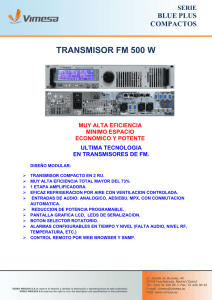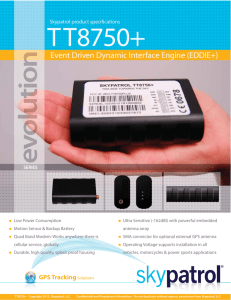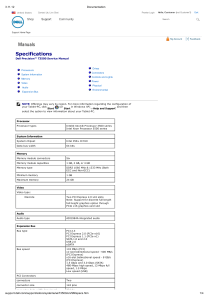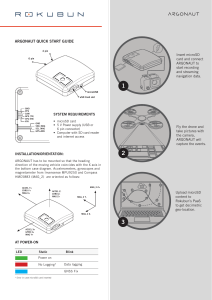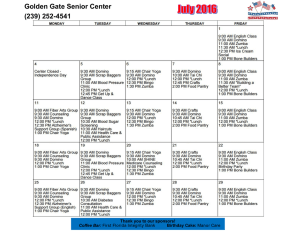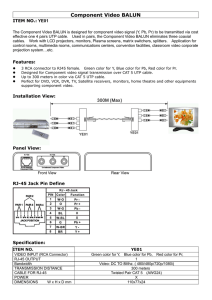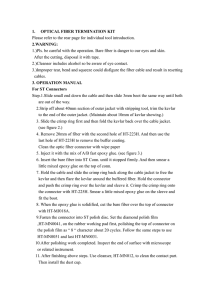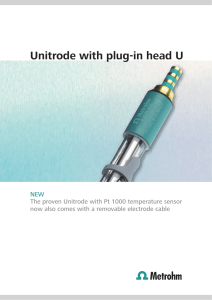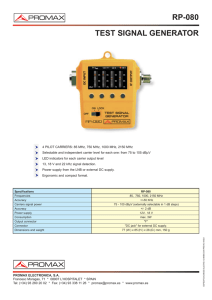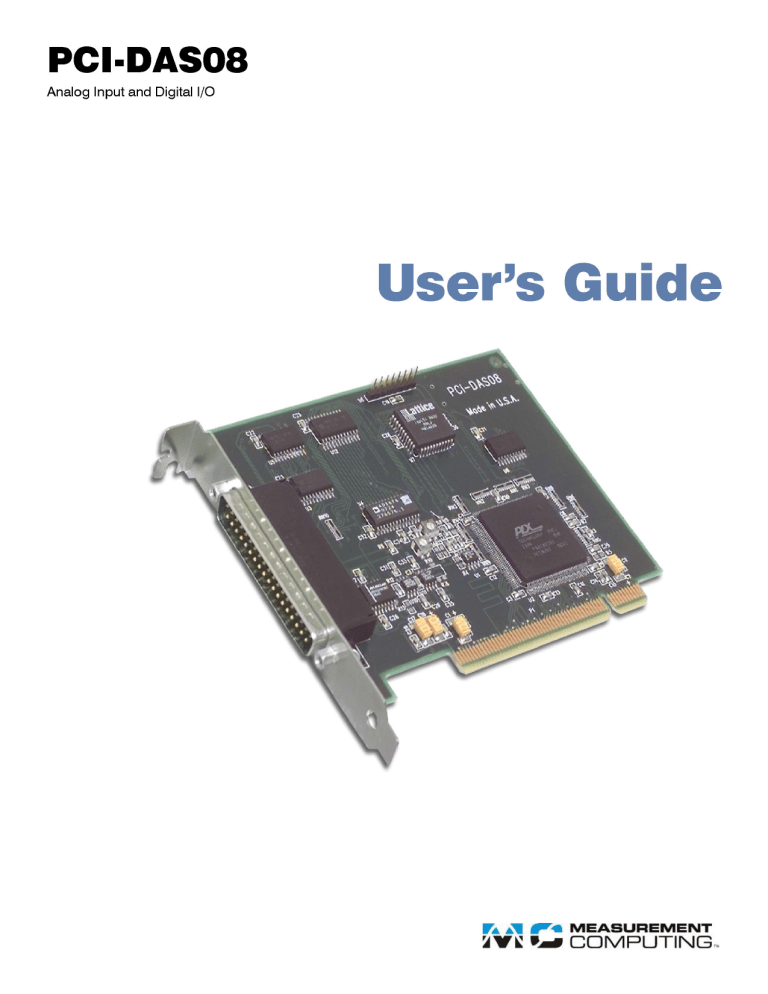
PCI-DAS08 Analog input and Digital I/O User's Guide Document Revision 5A, June, 2006 © Copyright 2006, Measurement Computing Corporation Trademark and Copyright Information Measurement Computing Corporation, InstaCal, Universal Library, and the Measurement Computing logo are either trademarks or registered trademarks of Measurement Computing Corporation. Refer to the Copyrights & Trademarks section on mccdaq.com/legal for more information about Measurement Computing trademarks. Other product and company names mentioned herein are trademarks or trade names of their respective companies. © 2006 Measurement Computing Corporation. All rights reserved. No part of this publication may be reproduced, stored in a retrieval system, or transmitted, in any form by any means, electronic, mechanical, by photocopying, recording, or otherwise without the prior written permission of Measurement Computing Corporation. Notice Measurement Computing Corporation does not authorize any Measurement Computing Corporation product for use in life support systems and/or devices without prior written consent from Measurement Computing Corporation. Life support devices/systems are devices or systems that, a) are intended for surgical implantation into the body, or b) support or sustain life and whose failure to perform can be reasonably expected to result in injury. Measurement Computing Corporation products are not designed with the components required, and are not subject to the testing required to ensure a level of reliability suitable for the treatment and diagnosis of people. HM PCI-DAS08.doc ii iii Table of Contents Preface About this User's Guide .......................................................................................................................v What you will learn from this user's guide .........................................................................................................v Conventions in this user's guide .........................................................................................................................v Where to find more information.........................................................................................................................v Chapter 1 Introducing the PCI-DAS08 .............................................................................................................. 1-1 Overview: PCI-DAS08 features ..................................................................................................................... 1-1 Software features ............................................................................................................................................ 1-1 PCI-DAS08 block diagram............................................................................................................................. 1-2 Chapter 2 Installing the PCI-DAS08 .................................................................................................................. 2-1 What comes with your shipment? .................................................................................................................. 2-1 Hardware ....................................................................................................................................................................... 2-1 Additional documentation.............................................................................................................................................. 2-1 Optional components ..................................................................................................................................................... 2-1 Unpacking the PCI-DAS08 ............................................................................................................................ 2-2 Installing the software .................................................................................................................................... 2-2 Installing the PCI-DAS08............................................................................................................................... 2-2 Configuring the PCI-DAS08 .......................................................................................................................... 2-3 Connecting the board for I/O operations ........................................................................................................ 2-3 Connectors, cables – main I/O connector ...................................................................................................................... 2-3 Field wiring, signal termination and signal conditioning............................................................................................... 2-4 Chapter 3 Programming and Developing Applications .................................................................................. 3-1 Programming languages ................................................................................................................................. 3-1 Packaged application programs ...................................................................................................................... 3-1 Register-level programming ........................................................................................................................... 3-1 Chapter 4 Specifications.................................................................................................................................... 4-1 Analog input ................................................................................................................................................... 4-1 Digital input / output ...................................................................................................................................... 4-1 Counter section............................................................................................................................................... 4-2 Power consumption ........................................................................................................................................ 4-2 Environmental ................................................................................................................................................ 4-2 Main connector and pin out............................................................................................................................ 4-3 iv Preface About this User’s Guide What you will learn from this user's guide This user's guide describes the Measurement Computing PCI-DAS08 data acquisition board and lists hardware specifications. Conventions in this user's guide For more information Text presented in a box signifies additional information related to the subject matter. Caution! Shaded caution statements present information to help you avoid injuring yourself and others, damaging your hardware, or losing your data. bold text Bold text is used for the names of objects on a screen, such as buttons, text boxes, and check boxes. italic text Italic text is used for the names of manuals and help topic titles, and to emphasize a word or phrase. Where to find more information Additional information about PCI-DAS08 hardware is available on our website at www.mccdaq.com. You can also contact Measurement Computing Corporation with specific questions. Knowledgebase: kb.mccdaq.com Tech support form: www.mccdaq.com/support/support_form.aspx Email: [email protected] Phone: 508-946-5100 and follow the instructions for reaching Tech Support For international customers, contact your local distributor. Refer to the International Distributors section on our website at www.mccdaq.com/International. v Chapter 1 Introducing the PCI-DAS08 Overview: PCI-DAS08 features This manual explains how to configure, install, and use your PCI-DAS08 board. The PCI-DAS08 is a multifunction measurement and control board designed to operate in computers with PCI bus accessory slots. The PCI-DAS08 board provides the following features: ! ! ! ! ! ! ! Eight single-ended 12-bit analog inputs 12-bit A/D resolution Sample rates of up to 40 kHz ±5V input range Three 16-bit counters Seven digital I/O bits (three input, four output) Connector compatible with Measurement Computing’s ISA-based CIO-DAS08 board The PCI-DAS08 board is completely plug-and-play, with no jumpers or switches to set. All board addresses are set by the board's plug-and-play software. Software features For information on the features of InstaCal and the other software included with your PCI-DAS08, refer to the Quick Start Guide that shipped with your device. The Quick Start Guide is also available in PDF at www.mccdaq.com/PDFmanuals/DAQ-Software-Quick-Start.pdf. Check www.mccdaq.com/download.htm for the latest software version or versions of the software supported under less commonly used operating systems. 1-1 PCI-DAS08 User's Guide Introducing the PCI-DAS08 PCI-DAS08 block diagram PCI-DAS08 functions are illustrated in the block diagram shown here. Buffer 10 Volt Reference Gain and Offset Cal Buffer Analog In 8 CH S.E. 12-bit, 100 kHz Mux Start EOC A/D Control Channel Select 82C54 16-bit Counters Gate2 Output Clock2 Counter 0 Counter 1 Controller FPGA and Logic Control Input Clock0 Gate0 Output Clock0 Input Clock1 Gate1 Output Clock1 ADC and MUX Control Counter 2 Counter 2 Clock Input Clock2 (33 MHz/8) Output Port Control Output (3:0) Input Port Interrupt Control Output Clock2 EXT_INT Decode/Status Digital I/O Input (2:0) Channel Select Bus Timing LOCAL BUS Boot EEPROM PCI Controller BADR1 BADR2 Interrupt PCI BUS (5 V, 32-BIT, 33 MHZ) Figure 1-1. PCI-DAS08 block diagram 1-2 Chapter 2 Installing the PCI-DAS08 What comes with your shipment? The following items are shipped with the PCI-DAS08: Hardware ! PCI-DAS08 Additional documentation In addition to this hardware user's guide, you should also receive the Quick Start Guide (available in PDF at www.mccdaq.com/PDFmanuals/DAQ-Software-Quick-Start.pdf). This booklet supplies a brief description of the software you received with your PCI-DAS08 and information regarding installation of that software. Please read this booklet completely before installing any software or hardware. Optional components ! Cables C37FF-x C37FFS-x 2-1 PCI-DAS08 User's Guide ! Installing the PCI-DAS08 Signal termination and conditioning accessories MCC provides signal termination products for use with the PCI-DAS08. Refer to the "Field wiring, signal termination and signal conditioning" section for a complete list of compatible accessory products. Unpacking the PCI-DAS08 As with any electronic device, you should take care while handling to avoid damage from static electricity. Before removing the PCI-DAS08 from its packaging, ground yourself using a wrist strap or by simply touching the computer chassis or other grounded object to eliminate any stored static charge. If any components are missing or damaged, notify Measurement Computing Corporation immediately by phone, fax, or e-mail: ! ! ! ! Phone: 508-946-5100 and follow the instructions for reaching Tech Support. Fax: 508-946-9500 to the attention of Tech Support Email: [email protected] Installing the software Refer to the Quick Start Guide for instructions on installing the software on the Measurement Computing Data Acquisition Software CD. This booklet is available in PDF at www.mccdaq.com/PDFmanuals/DAQ-SoftwareQuick-Start.pdf. Installing the PCI-DAS08 The PCI-DAS08 board is completely plug-and-play. There are no switches or jumpers to set. To install your board, follow the steps below. Install the MCC DAQ software before you install your board The driver needed to run your board is installed with the MCC DAQ software. Therefore, you need to install the MCC DAQ software before you install your board. Refer to the Quick Start Guide for instructions on installing the software. 1. Turn your computer off, remove the cover, and insert your board into an available PCI slot. 2. Close your computer and turn it on. If you are using an operating system with support for plug-and-play (such as Windows 2000 or Windows XP), a dialog box pops up as the system loads indicating that new hardware has been detected. If the information file for this board is not already loaded onto your PC, you will be prompted for the disk containing this file. The MCC DAQ software contains this file. If required, insert the Measurement Computing Data Acquisition Software CD and click OK. 3. To test your installation and configure your board, run the InstaCal utility installed in the previous section. Refer to the Quick Start Guide that came with your board for information on how to initially set up and load InstaCal. If your board has been powered-off for more than 10 minutes, allow your computer to warm up for at least 15 minutes before acquiring data. This warm-up period is required for the board to achieve its rated accuracy. The high speed components used on the board generate heat, and it takes this amount of time for a board to reach steady state if it has been powered off for a significant amount of time. 2-2 PCI-DAS08 User's Guide Installing the PCI-DAS08 Configuring the PCI-DAS08 All hardware configuration options on the PCI-DAS08 are software controlled. There are no switches or jumpers to set. Connecting the board for I/O operations Connectors, cables – main I/O connector Table 2-1 lists the board connectors, applicable cables and compatible accessory boards. Table 2-1. Board Connectors, cables, accessory equipment Connector type Compatible cables Compatible accessory products (with the C37FF-x cable) Compatible accessory products (with the C37FFS-x cable) 37-pin male "D" connector ! C37FF-x 37-pin cable. x = length in feet (Figure 2-2). ! C37FFS-x 37-pin shielded cable. x = length in feet (Figure 2-3). CIO-MINI37 SCB-37 ISO-RACK08 CIO-MINI37 SCB-37 ISO-RACK08 CIO-EXP16 CIO-EXP32 CIO-EXP-GP CIO-EXP-BRIDGE16 CIO-EXP-RTD16 -12V CTR1 GATE CTR2 GATE CTR3 GATE EXT INT DIN1 DIN2 DIN3 DGND +5V CH7 CH6 CH5 CH4 CH3 CH2 CH1 CH0 CTR1 CLK CTR1 OUT CTR2 CLK CTR2 OOUT CTR3 OUT DOUT1 DOUT2 DOUT3 DGND LLGND LLGND LLGND LLGND LLGND LLGND LLGND Figure 2-1. Main connector pinout 2-3 PCI-DAS08 User's Guide Installing the PCI-DAS08 The red stripe identifies pin # 1 1 1 20 20 37 37 19 19 Figure 2-2. C37FF-x cable 1 19 1 20 37 19 20 37 Figure 2-3. C37FFS-x cable Caution! If either the AC or DC voltage is greater than 5 volts, do not connect the PCI-DAS08 to this signal source. You are beyond the board's usable input range and will need to either adjust your grounding system or add special isolation signal conditioning to take useful measurements. A ground offset voltage of more than 7 volts may damage the PCI-DAS08 board and possibly your computer. An offset voltage much greater than 7 volts will damage your electronics, and may be hazardous to your health. Field wiring, signal termination and signal conditioning You can use the following MCC screw terminal boards to terminate field signals and route them into the PCIDAS08 board using the C37FF-x or C37FFS-x cable: ! CIO-MINI37 – 37-pin screw terminal board. Details on this product are available at ! SCB-37 – 37 conductor, shielded signal connection/screw terminal box that provides two independent 50- www.mccdaq.com/cbicatalog/cbiproduct.asp?dept_id=102&pf_id=255. pin connections. Details on this product are available at www.mccdaq.com/cbicatalog/cbiproduct.asp?dept_id=196&pf_id=1166. MCC provides the following analog signal conditioning products for use with your PCI-DAS08 board: ! ! ! ISO-RACK08 – Isolated 8-channel, 5B module rack for analog signal conditioning and expansion. Details on this product are available on our web site at www.mccdaq.com/cbicatalog/cbiproduct.asp?dept_id=127&pf_id=449. CIO-EXP16 – 16-channel analog multiplexer board with on-board CJC sensor. Details on this product are available on our web site at www.mccdaq.com/cbicatalog/cbiproduct.asp?dept_id=126&pf_id=249. CIO-EXP32 – 32-channel analog multiplexer board with on-board CJC sensor and 2 Gain amps. Details on this product are available on our web site at www.mccdaq.com/cbicatalog/cbiproduct.asp?dept_id=126&pf_id=250. 2-4 PCI-DAS08 User's Guide ! ! ! Installing the PCI-DAS08 CIO-EXP-GP – 8-channel expansion multiplexer board with resistance signal conditioning. Details on this product are available on our web site at www.mccdaq.com/cbicatalog/cbiproduct.asp?dept_id=126&pf_id=244. CIO-EXP-BRIDGE16 – 16-channel expansion multiplexer board with Wheatstone bridge signal conditioning. Details on this product are available on our web site at www.mccdaq.com/cbicatalog/cbiproduct.asp?dept_id=126&pf_id=243. CIO-EXP-RTD16 – 16-channel expansion multiplexer board with RTD signal conditioning. Details on this product are available on our web site at www.mccdaq.com/cbicatalog/cbiproduct.asp?dept_id=126&pf_id=248. Information on signal connections General information regarding signal connection and configuration is available in the Guide to Signal Connections. This document is available at http://www.measurementcomputing.com/signals/signals.pdf. 2-5 Chapter 3 Programming and Developing Applications After following the installation instructions in Chapter 2, your board should now be installed and ready for use. Although the board is part of the larger DAS family, there is no correspondence among registers for different boards. Software written at the register level for other DAS models will not function correctly with the PCIDAS08 board. Programming languages Measurement Computing’s Universal Library™ provides access to board functions from a variety of Windows programming languages. If you are planning to write programs, or would like to run the example programs for Visual Basic or any other language, refer to the Universal Library User's Guide (available on our web site at www.mccdaq.com/PDFmanuals/sm-ul-user-guide.pdf). Packaged application programs Many packaged application programs, such as SoftWIRE and HP-VEE™, now have drivers for your board. If the package you own does not have drivers for the board, please fax or e-mail the package name and the revision number from the install disks. We will research the package for you and advise how to obtain drivers. Some application drivers are included with the Universal Library package, but not with the application package. If you have purchased an application package directly from the software vendor, you may need to purchase our Universal Library and drivers. Please contact us by phone, fax or e-mail: ! ! ! Phone: 508-946-5100 and follow the instructions for reaching Tech Support. Fax: 508-946-9500 to the attention of Tech Support Email: [email protected] Register-level programming You should use the Universal Library or one of the packaged application programs mentioned above to control your board. Only experienced programmers should try register-level programming. If you need to program at the register level in your application, you can find more information in the Register Map for the PCI-DAS08 Series (available at www.mccdaq.com/registermaps/RegMapPCI-DAS08.pdf). 3-1 Chapter 4 Specifications Typical for 25 °C unless otherwise specified. Specifications in italic text are guaranteed by design. Analog input Table 1. Analog input specifications Parameter Specification A/D converter type Resolution Ranges A/D pacing A/D triggering modes AD1674J 12 bits ±5 V Software polled Digital: Software polling of digital input (DIN1) followed by pacer loading and configuration. Software polled Bipolar 8 single-ended 10 µs 40 kHz typical, PC dependent ±1 LSB No missing codes guaranteed ±1 LSB ±180 ppm/°C ±60 ppm/°C ±60 nA max over temperature 10 MegOhm min ±35 V (Rate = 1-50 kHz, Average % ± 2 bins, Average % ± 1 bin, Average # bins) Bipolar (5 V): 100% / 100% / 3 bins Data transfer Polarity Number of channels A/D conversion time Throughput Relative accuracy Differential linearity error Integral linearity error Gain drift (A/D specs) Zero drift (A/D specs) Input leakage current Input impedance Absolute maximum input voltage Noise distribution Digital input / output Table 2. Digital I/O specifications Parameter Specification Digital type (main connector): Output: 74ACT273 Input: 74LS244 3 fixed input, 4 fixed output 7 3.94 volts min @ -24 mA (Vcc = 4.5 V) 0.36 volts max @ 24 mA (Vcc = 4.5 V) 2.0 volts min, 7 volts absolute max 0.8 volts max, -0.5 volts absolute min INTA# - mapped to IRQn via PCI BIOS at boot-time Programmable through PCI controller: 0 = disabled 1 = enabled (default) Configuration Number of channels Output high Output low Input high Input low Interrupts Interrupt enable 4-1 PCI-DAS08 User's Guide Interrupt sources Specifications External source (EXT INT) Polarity programmable through PCI controller: 1 = active high 0 = active low (default) Counter section Table 3. Counter specifications Parameter Specification Counter type Configuration Counter 0 - User counter 1 82C54 device 3 down counters, 16-bits each Source: Available at user connector (CTR1CLK) Gate: Available at user connector (CTR1GATE) Output: Available at user connector (CTR1OUT) Source: Available at user connector (CTR2CLK) Gate: Available at user connector (CTR2GATE) Output: Available at user connector (CTR2OUT) Source: Buffered PCI clock (33 MHz) divided by 8. Gate: Available at user connector (CTR3GATE) Output: Available at user connector (CTR3OUT) and may be software configured as Interrupt Pacer. 10 MHz max 30 ns min 50 ns min 50 ns min 50 ns min 0.8 V max 2.0 V min 0.4 V max 3.0 V min Counter 1 - User counter 2 Counter 2 - User counter 3 or Interrupt Pacer Clock input frequency High pulse width (clock input) Low pulse width (clock input) Gate width high Gate width low Input low voltage Input high voltage Output low voltage Output high voltage Power consumption Table 4. Power consumption specifications Parameter Specification +5 V operating (A/D converting to FIFO) +12 V -12 V 251 mA typical, 436 mA max 13 mA typical, 19 mA max 17 mA typical, 23 mA max Environmental Table 5. Environmental specifications Parameter Specification Operating temperature range Storage temperature range Humidity 0 to 50 °C -20 to 70 °C 0 to 90% non-condensing 4-2 PCI-DAS08 User's Guide Specifications Main connector and pin out Table 6. Main connector specifications Parameter Specification Connector type Compatible cables 37-pin male "D" connector ! C37FF-x cable ! C37FFS-x cable CIO-MINI37 SCB-37 ISO-RACK08 CIO-MINI37 SCB-37 ISO-RACK08 CIO-EXP16 CIO-EXP32 CIO-EXP-GP CIO-EXP-BRIDGE16 CIO-EXP-RTD16 Compatible accessory products with the C37FF-x cable Compatible accessory products with the C37FFS-x cable Table 7. Main connector pin out Pin Signal Name Pin Signal Name 1 2 3 4 5 6 7 8 9 10 11 12 13 14 15 16 17 18 19 +12V CTR1 CLK CTR1 OUT CTR2 CLK CTR2 OUT CTR3 OUT DOUT1 DOUT2 DOUT3 DOUT4 DGND LLGND LLGND LLGND LLGND LLGND LLGND LLGND 10V REF 20 21 22 23 24 25 26 27 28 29 30 31 32 33 34 35 36 37 -12V CTR1 GATE CTR2 GATE CTR3 GATE EXT INT DIN1 DIN2 DIN3 DGND +5V CH7 CH6 CH5 CH4 CH3 CH2 CH1 CH0 4-3 Declaration of Conformity Manufacturer: Address: Category: Measurement Computing Corporation 10 Commerce Way Suite 1008 Norton, MA 02766 USA Electrical equipment for measurement, control and laboratory use. Measurement Computing Corporation declares under sole responsibility that the product PCI-DAS08 to which this declaration relates is in conformity with the relevant provisions of the following standards or other documents: EU EMC Directive 89/336/EEC: Electromagnetic Compatibility, EN55022 (1995), EN55024 (1998) Emissions: Group 1, Class B ! EN55022 (1995): Radiated and Conducted emissions. Immunity: EN55024 ! ! ! ! ! ! ! EN61000-4-2 (1995): Electrostatic Discharge immunity, Criteria A. EN61000-4-3 (1997): Radiated Electromagnetic Field immunity Criteria A. EN61000-4-4 (1995): Electric Fast Transient Burst immunity Criteria A. EN61000-4-5 (1995): Surge immunity Criteria A. EN61000-4-6 (1996): Radio Frequency Common Mode immunity Criteria A. EN61000-4-8 (1994): Power Frequency Magnetic Field immunity Criteria A. EN61000-4-11 (1994): Voltage Dip and Interrupt immunity Criteria A. Declaration of Conformity based on tests conducted by Chomerics Test Services, Woburn, MA 01801, USA in September, 2001. Test records are outlined in Chomerics Test Report #EMI3053.01. We hereby declare that the equipment specified conforms to the above Directives and Standards. Carl Haapaoja, Director of Quality Assurance Measurement Computing Corporation 10 Commerce Way Suite 1008 Norton, Massachusetts 02766 (508) 946-5100 Fax: (508) 946-9500 E-mail: [email protected] www.mccdaq.com
